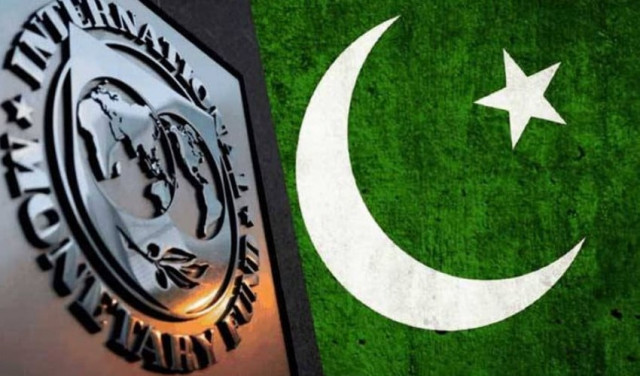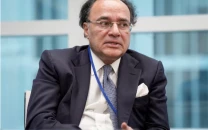IMF's Washington Consensus versus Beijing Consensus
While China's model lifts millions out of poverty, Pakistan's IMF-driven reforms seem to deepen economic inequality

"Practical men, who believe themselves to be quite exempt from any intellectual influence, are usually the slaves of some defunct economist. Madmen in authority, who hear voices in the air, are distilling their frenzy from some academic scribbler of a few years back," said John Maynard Keynes, the founder of Keynesian thought in economics, in the final chapter of his pathbreaking book — The General Theory of Employment, Interest and Money in 1936.
Today, Keynes's words may well apply to the economic policies that govern Pakistan. In our case, the defunct economist was a certain John Williamson, who returned to his Lord some four years ago. Dr Williamson, who held a PhD in Economics from Princeton and taught there and at other prestigious universities such as MIT, served as the chief economist for South Asia at the World Bank from 1996 to 1999. He is best known for coining the term "Washington Consensus" — this was a set of 10 economic policy prescriptions, emphasising fiscal discipline, trade liberalisation, and privatisation.
In its original form, Williamson had intended the Washington Consensus to be a rough set of guidelines, to be applied with common sense and flexibility in accordance with the specific needs of the country. Unfortunately, Williamson's carefully laid out treatise fell into the hands of the minions of the World Bank and the International Monetary Fund (IMF). These are institutions known for hiring some of the smartest people and then doing their utmost to squeeze all creativity and independence of thought from their new recruits, rendering them automatons committed to the unquestioning enforcement of what they preach.
And so it was that Williamson's loose set of guidelines became gospel, immune to doubt, flexibility, or change — to be applied ruthlessly to "saving" sinking developing economies around the world. It is this prescription — the Washington Consensus – that the IMF has foisted on Pakistan.
The ten principles of the consensus are: fiscal discipline, cutting subsidies, tax reform, market-based interest rates, competitive exchange rates to encourage exports, trade liberalisation such as reducing duties on imports, encouraging foreign direct investment, privatisation, deregulation, and finally, respect for property rights. All these principles, for some time now, have been pushed down the throat of Pakistan's government. The question is: has the Washington Consensus worked for Pakistan? A simple comparison with China, which followed sufficiently distinct policies to merit the name "Beijing Consensus," may provide an answer.
The numbers tell the story. In 1962, China's GDP per capita was $70, while Pakistan's was $90. By 1973, there was a brief reversal: China had $155 and Pakistan still $90. By 1980, China's figure was $308 and Pakistan's $479. This gap continued until 1993, when China decisively began pulling ahead. Today, China's GDP per capita is more than eight times that of Pakistan. To understand why, let's contrast the Washington Consensus as applied to Pakistan with the Beijing Consensus followed by China. Pakistan adopted many Washington Consensus-style reforms, especially under IMF programmes and structural adjustment policies.
Here's how they played out: 1) Fiscal discipline: Pakistan struggled with high fiscal deficits. Reforms aimed to reduce government borrowing, but persistent debt and inefficient spending remained challenges. 2) Tax reform: Efforts to broaden the tax base were made, but Pakistan's large informal economy and tax evasion limited success. 3) Privatisation & deregulation: State-owned enterprises were privatised, but outcomes were mixed, some sectors saw efficiency gains, others faced backlash due to job losses and poor regulation. 4) Trade liberalisation: Tariffs were reduced and markets opened, but domestic industries often couldn't compete, leading to trade imbalances. 5) Foreign direct investment (FDI): Policies encouraged FDI, but political instability and weak infrastructure deterred sustained inflows. Despite these reforms, Pakistan's average growth rate hovered around 3% - far below the 7% needed to reduce debt and create jobs.
Now, contrast this with the Beijing Consensus: China's model emphasises state-led development, gradual reform, and pragmatic experimentation.
Key features include: 1) Strong government role: The state controls key sectors like energy and finance, guiding long-term planning. 2) Incremental reform: Instead of shock therapy, China implemented changes step-by-step, allowing adaptation and stability. 3) Focus on welfare: Development isn't just about GDP – it includes poverty reduction, infrastructure, and quality of life. 4) Export-led growth: China used manufacturing and trade to drive growth, supported by strategic investments and incentives. 5) Merit-based bureaucracy: Officials are rewarded for economic performance, creating incentives for innovation and efficiency. The Beijing Consensus has turbocharged China's growth, transforming it from a neglected backwater into a global economic powerhouse. Since 2000, about 400 million people have been lifted out of extreme poverty in China. The poverty rate has declined from about 40% in 2000 to about 10% today. Contrast this with Pakistan: under the Washington Consensus, poverty has increased from about 35% in 2000 to 45% in 2025.
So, what is the lesson here? Any set of policy prescriptions for economic development must not be based on blind dogma, as is the case with the IMF's implementation of the Washington Consensus. Policies must be tailored to the specific circumstances and needs of the country to which they are applied. In this sense, the IMF has rendered a great disservice to Pakistan by compelling us to adopt policies that do more harm than good.
THE WRITER IS CHAIRMAN OF MUSTAQBIL PAKISTAN AND HOLDS AN MBA FROM HARVARD BUSINESS SCHOOL




















COMMENTS
Comments are moderated and generally will be posted if they are on-topic and not abusive.
For more information, please see our Comments FAQ